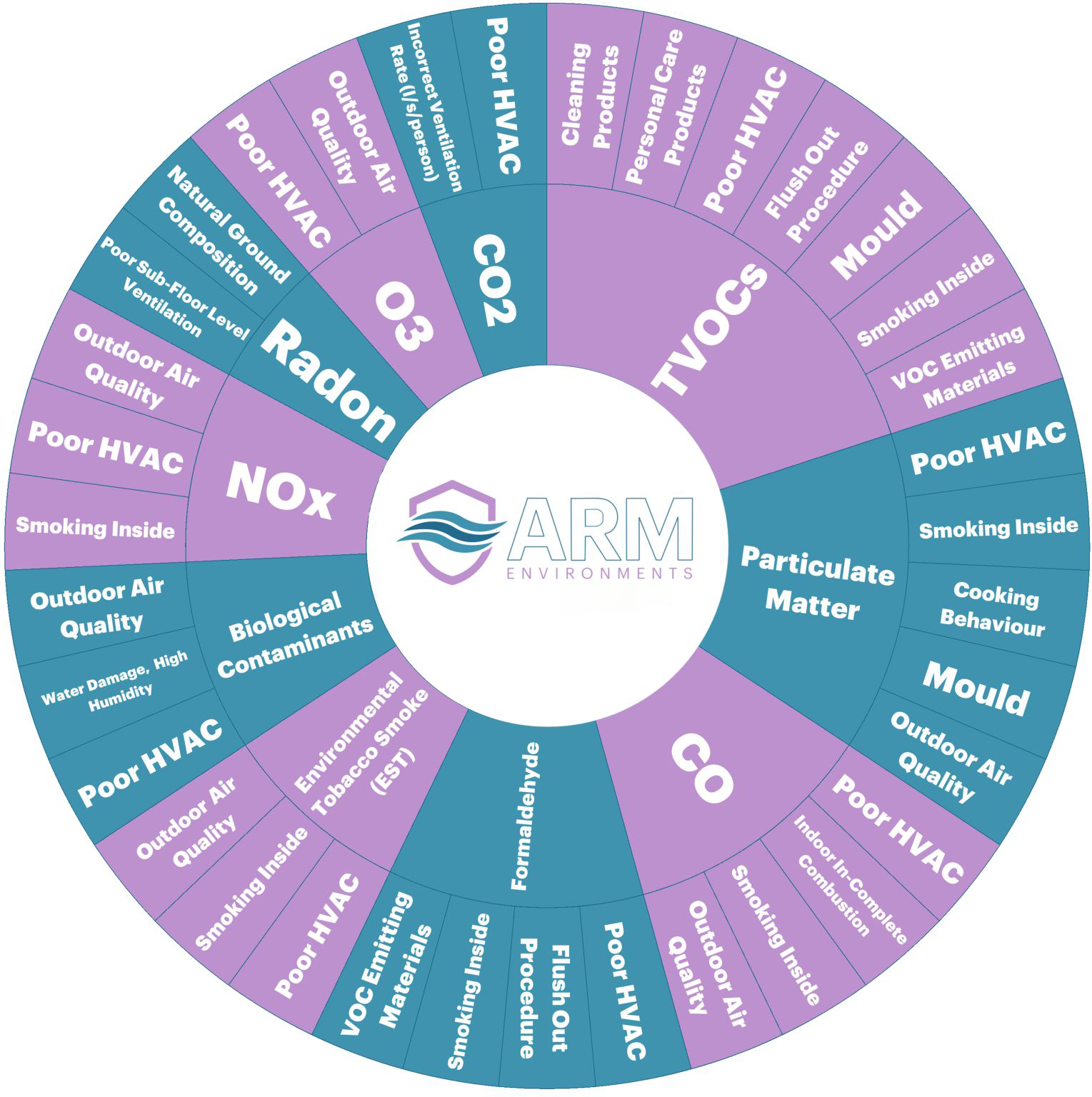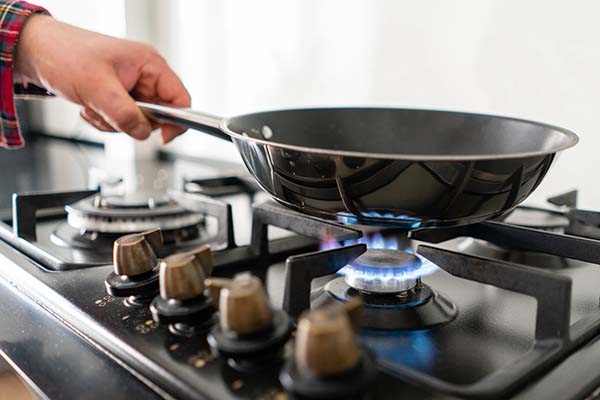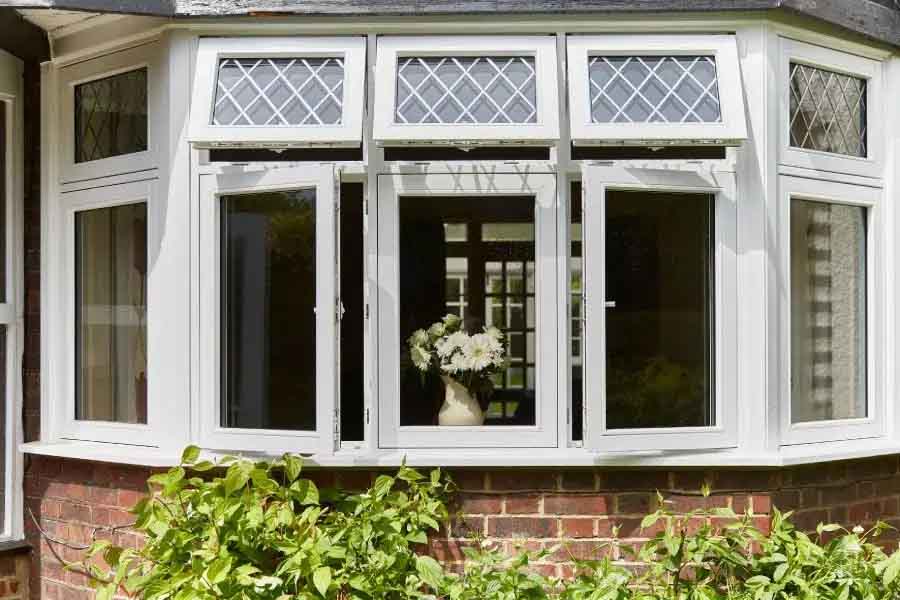Indoor pollutants: What are they and where do they come from?
When we think about pollution, most of us picture smoggy skylines or busy motorways. Yet the air inside our homes, offices, and schools can often be more polluted than the air outdoors. The particles and gases that fill our indoor spaces are known as indoor pollutants, and understanding them is the first step towards healthier, more indoor spaces.
What are Indoor Pollutants?
An indoor pollutant is any substance in the air that could harm people’s health, comfort, or productivity. Some are microscopic particles, some are gases, and others are living organisms. They vary in how they behave, where they come from, and how they affect us.
Broadly speaking, the most common indoor pollutants fall into four main groups:
Particulates: solid or liquid particles suspended in the air (such as dust, soot, or fibres). These are typically measured as PM10 (Particulate Matter of 10 micrometres or less), PM2.5, or PM1. The smaller particles are usually more dangerous.
Volatile Organic Compounds (VOCs): gases released from certain solids and liquids, like cleaning products or paints. These are often measured as Total Volatile Organic Compounds (TVOCs) as ‘VOCs’ are composed of various different compounds and it is initially considered too time consuming and expensive to measure for each compound independently. These are individually tested for if an inexplicably high TVOC reading is initially recorded.
Gaseous pollutants: including carbon dioxide (CO₂), carbon monoxide (CO), ozone (O₃), and nitrogen dioxide (NO₂). Some can be detected through smell and some cannot.
Biological pollutants: such as mould spores, bacteria, viruses, or pollen.
Note: this is a simplified view of pollutants; many of them overlap with each other (e.g., mould being both a particulate and a biological pollutant) or can be regarded independently outside of their category (e.g., Formaldehyde is often assessed independently even though it can be classed as a VOC).

Where Do Indoor Pollutants Come From?
The sources are surprisingly diverse, and many of them are everyday items or activities we rarely think twice about.
- The Building Itself
Modern buildings are designed to be energy efficient, which often means they’re well-sealed. Unfortunately, that also means pollutants can build up indoors. Common culprits include:
- Off-gassing from construction materials (paints, adhesives, insulation, and flooring).
- Dust from plaster or concrete that’s released during maintenance or refurbishment.
- Moisture build-up in poorly ventilated areas, leading to mould growth.
- Furniture and Fittings
Soft furnishings, carpets, and even office furniture can emit VOCs. New products tend to release higher levels, particularly in the first few weeks after installation. This is why new products can have something like a ‘new car smell’ – and yes, that’s the result of potentially harmful gases.
- Everyday Activities
Pollution can build up within a space through a variety of different activities, including cooking, cleaning, printing, and even breathing. It’s near impossible to inhabit a space without polluting it in some way or another.
- Cleaning sprays, scented items, and candles all release VOCs into a space – a good smell isn’t necessarily healthy. Typically, the best smell is no smell at all.
- Cooking generates particulates. Gas hobs release Nitrogen Dioxide when in use and can potentially become a source of Carbon Monoxide, which is why it’s so important to properly ventilate any kitchen and ensure a CO detector is fitted.
- Office equipment, like printers and photocopiers, can produce Ozone and fine particles (PM1, PM2.5)
- From Outdoors
Depending on your area (and you can check the Air Quality Index locally via a quick Google search), your outdoor air might harbour high concentrations of pollutants, particularly from sources like busy roadways and industrial processes (factories, mechanics, distribution centres, etc). Biological pollutants, like mould and pollen, can enter your space via an open window and contribute towards an overall unhealthy indoor environment.
Common indoor pollutants and their sources
Here are some of the most common pollutants we come across indoors and where they might come from:
|
Pollutant |
Main Sources |
|
Particulate Matter (PM₂.₅, PM₁₀) |
Cooking (especially frying), candles, smoking, fireplaces, outdoor air infiltration, construction dust |
|
Carbon Dioxide (CO₂) |
Human respiration, inadequate ventilation, combustion appliances |
|
Carbon Monoxide (CO) |
Faulty boilers, gas heaters, fireplaces, vehicle exhaust in attached garages |
|
Nitrogen Dioxide (NO₂) |
Gas cookers and heaters, tobacco smoke, vehicle exhaust drawn indoors |
|
Volatile Organic Compounds (VOCs) |
Paints, varnishes, cleaning products, air fresheners, carpets, furniture, adhesives |
|
Formaldehyde (a common VOC) |
Pressed-wood products, furniture, flooring, textiles, glues |
|
Ozone (O₃) |
Office equipment (printers, photocopiers), some air purifiers, outdoor air |
|
Radon |
Naturally occurring gas seeping from soil and rock through building foundations (especially in certain UK regions) |
|
Biological Contaminants |
Mould spores, bacteria, viruses, pollen, pet dander, dust mites |
|
Asbestos Fibres |
Older building materials, insulation, floor tiles (when disturbed or damaged) |
|
Lead Particles |
Old paint, contaminated dust, renovation work in older buildings |
|
Moisture and Dampness |
Poor ventilation, leaks, condensation — encourages mould and microbial growth |
How to reduce indoor pollution
The good news is that you can improve your indoor air quality quite easily by simply understanding the sources of pollution in your space. With an air quality monitor, you might detect a pollution spike around rush hour, so it could be a good idea to reduce ventilation around this time. If you know when outdoor air quality is good, prioritise opening windows or activating your HVAC (if possible) around this time to flush out the space with cleaner outdoor air.
Here are some more key ways you can improve your indoor air quality, even without an expensive HVAC:
- Identify and reduce sources by choosing low-VOC materials and products. If you introduce a new item of furniture, ventilate the space well for a few hours or until the smell has disappeared. Avoid using scented products.
- Time the ventilation by scheduling according to activities and air quality. When cooking, always ensure a space is ventilated (e.g., turn on the extractor fan). Opening windows or activating mechanical ventilation at night is typically a good way to introduce cleaner air, but be mindful of cooling the space down too much.
- Filter the air via HVAC filters or smaller air purification units. Buildings with HVAC should have the HVAC filters checked regularly (at least once a year, or as per manufacturer/technician guidance) to ensure they’re still clean and allow air to pass through.
- Monitor consistently by purchasing an air quality monitor/sensor (these range in price, but the more expensive ones are typically much more accurate) to detect poor air quality before someone gets sick, and to find the actual sources of pollution. Measure improvements over time and provide valuable data to air quality experts (like us!) if something ever goes wrong or you need air quality help.
The takeaway
Understanding air quality is a great way to keep people safe. Without understanding which pollutants are harmful and where they can originate from, indoor spaces can quickly affect people’s productivity and wellbeing and potentially introduce long-term health risks. By understanding what to look out for AND installing an air quality monitor, you’re protected against any surprise health risks.
With that being said, diagnosing and remediating an air quality issue is often much more complicated than detecting it. That’s where we come in. If you can spot an issue and provide us with the air quality data, we can be one step closer to fixing it in a timely and effective manner. Even if you don’t have any data, just getting in contact sooner rather than later can be the difference between fixing a source of pollution before it becomes a problem and having a family member, colleague, or resident fall sick because of an air quality issue. If you’re concerned that something might be wrong and you’d like us to help, get in touch today.
FAQs
What are the most harmful indoor pollutants?
The pollutants most commonly associated with health risks are fine particulates (especially PM₂.₅), carbon monoxide, nitrogen dioxide, VOCs, and mould spores. Each behaves differently, but the smaller and more reactive a pollutant is, the more likely it is to affect breathing, cognition, or long-term health. Homes with gas appliances, low ventilation, or dampness tend to experience the greatest concentrations. If you are concerned that particularly dangerous pollutants might be in your building, you can book an air quality test with us.
How dangerous is Carbon Dioxide (CO2)?
CO2 itself is not particularly dangerous until experienced in very high doses. 'High' concentrations begin at around 1000ppm at which level drowsiness can be experienced. The Workplace Exposure Limit (WEL) for CO2 is 5000ppm over 8 hours. This level is rarely reached within indoor spaces, however, as typical room concentrations sit at around 400-600ppm, and basic window ventilation can easily and quickly reset CO2 levels. The best way to ensure CO2 levels remain safe within heavily-occupied or industrial spaces is to install and use air quality monitors or book an air quality test with us.
How can I tell if my indoor air quality is poor?
The quickest way is to use a monitor, but you can also look for warning signs such as persistent condensation, musty smells, headaches, fatigue, or irritation of the eyes and throat. These symptoms often coincide with elevated CO₂, VOCs, or humidity, even if the room looks clean.
When should I ventilate my space?
Opening a window helps only when outdoor air is cleaner than indoor air, and during rush hour or periods of high pollen, it may worsen indoor conditions. Timed ventilation, such as airing a space at night or early morning, is usually more effective. HVAC and MVHR systems can prevent intake of outdoor pollutants when accompanied with high-quality filters, however filters will quickly degrade and require replacement if constantly working during high-pollution periods of the day, so timed ventilation can help reduce waste and keep maintenance costs low.
For office spaces or high-occupancy rooms, you can learn more about our smart Air Quality Determined Ventilation system which optimises IAQ by only ventilating during the most appropriate times, every day.
Why do new homes and refurbished buildings have stronger pollutant levels?
Fresh materials release VOCs, adhesives off-gas for weeks, and sealed building envelopes trap emissions that would otherwise disperse. New carpets, paint, and furniture can all create a temporary rise in TVOCs until the space is ventilated adequately.
Are air purifiers worth using?
Air purifiers are useful if they contain a HEPA filter for particulates and an activated carbon stage for gases. They cannot fix the underlying source of pollution, but they can reduce exposure, especially in rooms with limited natural ventilation. To fix the root issue, it's advisable to book an air quality test to find the pollution source, which can often be something as easily-overlooked as a cooking appliance or new piece of furniture, but the only way to know is via testing, monitoring, and remediating.
How often should ventilation or HVAC filters be replaced?
Most systems need at least an annual check, though higher-use buildings may require more frequent changes. A clogged filter restricts airflow and can allow pollutants to recirculate, undermining the point of the system entirely. Any filters that have been running for longer than a year without being serviced should be checked over or changed to ensure maximum energy efficiency, high air pressure levels, and legal compliance. We offer a professional filter change service across the UK for HVAC/MVHR and kitchens, get in contact here.





